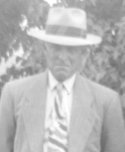 Ray was born on February 11, 1898 in Grouse Creek in a three-room log house, just back of the rock granary by the big brick house across the road from the tie house. (The family lived in this little house before the red brick home was built, and while it was being built.) Ray was the first son born to Allan Newman Tanner and Mary Emily Barlow. A sister, Amanda (Mandy) was two years older than Ray. They had a brother Lester, who was next to Ray. He died in 1924. Later, there were twin brothers, Herbert and Delbert, a brother, Joseph, who died while a young child, two more sisters, Evelyn and Bertha, and another brother, David Edwin (Ted). Much of this story is told by Amanda.
Ray was born on February 11, 1898 in Grouse Creek in a three-room log house, just back of the rock granary by the big brick house across the road from the tie house. (The family lived in this little house before the red brick home was built, and while it was being built.) Ray was the first son born to Allan Newman Tanner and Mary Emily Barlow. A sister, Amanda (Mandy) was two years older than Ray. They had a brother Lester, who was next to Ray. He died in 1924. Later, there were twin brothers, Herbert and Delbert, a brother, Joseph, who died while a young child, two more sisters, Evelyn and Bertha, and another brother, David Edwin (Ted). Much of this story is told by Amanda.
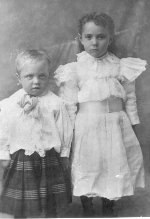
Raymond & Amanda Tanner
When he was little (I can’t remember the age) Ray had eczema. It was all over his face and even in his hair. He had to wear a night cap at night, and they put stockings on his hands at night so he couldn’t scratch himself. As he grew older, he seemed to outgrow it. It seemed as though when he got older he also was bothered with asthma and hay fever, which stayed with him as long as he lived. He had to take his atomizer with him all the time.
Also, when he was young he was very proud of his clothing and dress. For Christmas or a birthday one time he got a pair of arm bands. They were pink, about an inch wide, with a bow or pink ribbon on them. He was so pleased with them and so tickled, at church he said, “I wish the Bishop would say, ‘All the boys take off their coats.” Mother asked, “What for?” and he answered, “So they could see my pretty arm bands.”
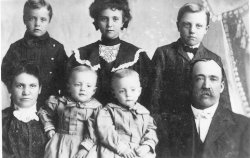
Raymond, Amanda, Leslie, Emily, Herbert, Delbert & Allen Tanner
Ray was always the first one through with breakfast and to get ready for school. The school bus was a wagon with seats along the side. Way down where Winfred’s field is, north of the old Ray Kimber place, you could see it coming. Ray would get through with his breakfast and get his books and stand by the window and watch, reporting where it was all the way up the road. He’d say, “The Bander’s a-coming.” “Here comes the Bander.” (We called it the Band Wagon or The Bander.)
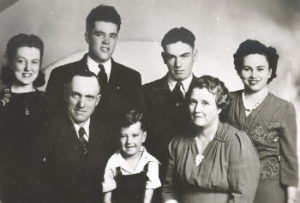
Flora, Wayne, Lewis, Alta, Ray, Harvey & Sarah Tanner
When Dad was on his mission, we spent Christmas Eve at Grandma Tanner’s over at Etna. Mother went to the Christmas Eve party with her brothers, Ralph and Val, and left us all with Grandma. They stayed in Grouse Creek that night and came back the next day to have the tree. Ray was always anxious to be first–always. On Christmas morning, it was always a custom in our family to be the first to say, “Christmas gift!” My dad learned it when he was a little boy and taught it to the whole family.
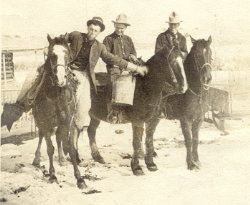
Mark Quinn, Jorgensen & Ray Tanner
Ray was always a lover of horses. He had a horse named Don that he rode all the time when he was about eleven or twelve. As he grew older, he went on the cattle outfit. Being the oldest boy, he carried on a lot of duties with his father.
We often played games as kids. We played hide-and-seek and run-sheep-run. When there was a lot of snow on the ground at school we played dogs and deer. (Like fox and geese.) I don’t remember Ray ever playing much in sports, but he was fond of horses and loved the horse races.
Ray was very good at history and current events and was always very punctual. He was a good mathematician. He chaperoned his sister, Mandy, to dances.
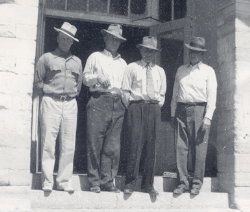
Archie Toyn, Winfred Kimber, Raymond Tanner & George (Kid) Blanthorn
He worked in the Grouse Creek Ward MIA, in the Presidency and as a secretary also. He was a Ward Teacher. He was a Financial Clerk for many years.
Ray married Sarah Grace Wakefield, the second daughter of Milas E. Wakefield and Annie Elizabeth Kimber. In the early years of their marriage they moved about, staying with relatives or renting various homes in Grouse Creek. When the little house, constructed from ties taken from the Transcontinental Railroad, was built across the road from the brick house, in 1924, they moved into it and lived there with their growing family, until they moved into the big Barlow home up near the store (1948). Lewis and Wayne were born in the tie house. Harvey was born in the hospital in Ogden.
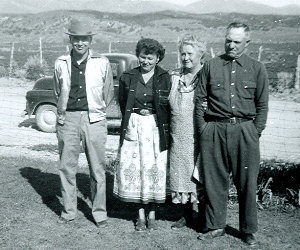
Bill Clucas, Alta Clucas, Sarah Tanner & Raymond Tanner
Ray was not one to boast, but there were some things in his life in which he excelled and in which he took great pride. The Tanner Brothers Hereford cattle herd was one of these. The herd evolved from a shorthorn bull that was purchased in the East by Kazar, a breeder at Deeth, Nevada. Allen Newman Tanner had the bull purchased and left at Lucin, Utah off the S.P. Railroad. The bull was then transported by sleigh and team from Lucin to Grouse Creek. In later years, a bull was purchased each year out of the Ogden Livestock Show. It was usually a Chandler bull from Oregon or a Wyoming Hereford Ranch bull out of Wyoming. The best bull, one who greatly increased the value of the herd was Mischief, a bull that left his mark in their herd for many years. Tanner Brothers purchased the bull at Peterson Brothers first bull sale at Roy, Utah and paid the highest price for a bull at the sale.
For many years Tanner yearlings were sold to a buyer named Emmett Edwards and shipped to California for 4-H kids to feed out and show.
Under Ray’s leadership, the ranch that was close to bankruptcy in 1929 was a prosperous operation in 1944.
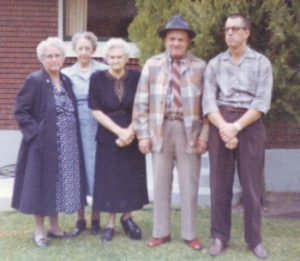
Sarah Tanner, Mrs Greenwell, Emily, Ray & Harvey Tanner
Ray rode some fine cow and cutting horses that were well known in Utah, Nevada and Idaho area. “Peaches” was a sorrel with white stocking legs and a strip on his face who was said by many to be the best reined cutting horse of his time. He was ridden with a hackamore. “Bird” was a sturdy, hardworking bay horse that Ray liked very much. “Babe” was a thoroughbred bay that Dad rode for fifteen years, and was hard to replace when he got old. “Betterstill” was Ray’s last horse, a thoroughbred out of Hitt’s herd in Malta, Idaho. He was one of the finer horses Ray rode and a regular pet. He was brought toKaysville, Utah where, he had a home until he died at the age of thirty one. All of Lewis’ children learned to ride on him.
There were many cowmen, cowboys and ranchers that Ray considered as friends. He respected them and they served as models throughout his cowboying years.
The friends included: Ernest Warburton, President of the White Rock Land and Livestock Co., George “Kid” Blanthorn, a rancher, neighbor and life long companion and friend, Jesse Barlow, an uncle who was one of the first cow foreman for the Utah Construction Co., also known as the U.C. or the Winecup, Newell Richins, cow foreman for the East Side cow wagon, neighbor and life long friend, Sidney Paskett, cow foreman for the U.C. South End, Ted King, rancher at Almo, Idaho, “Nigger” Henry, cow foreman at San Jacinto and son of Governor Sparks (owner of Sparks and Herold Cattle Co.), cattle foreman for Miller and Lux Cattle Co., Bert Cottle, who lived in Malta, Idaho in later life, and two cowboys, who worked for Miller and Lux Cattle Co., Chick McKnight and Cal Williams.
Ray was chairman of the Republican Party in Grouse Creek for more than twenty-five years and served in that office faithfully. He was the first secretary of the Grouse Creek Livestock Association and always a diligent worker in the Association. His philosophy was that the Association was there for the good of the community and not to be exploited by large ranching operations. Friends who put in innumerable hours of volunteer time with Ray to build up the Association were Gordon Hadfield, David and Billie Thomas, George “Kid” Blanthorn, Newell Richins, Thomas Warburton, Ivan Kimber and Edwin Kimber. Ray served as a Director and President of the East Grouse Creek Water Company for many years, working diligently to make this a fair and equitable company to serve the total community.
Ray worked untold hours doing community work to make it a better place to live. He tried to live his life by not reacting to controversy. His philosophy was that if you didn’t react you wouldn’t get a reaction in return.
Ray drove only two cars in his lifetime. The first was a new 1925 Chevrolet that he ran into the gate and broke it down, then parked the car and never drove it again. After he had turned sixty years of age, he drove Lewis’ 1947 green pickup truck with better success.
Ray had several opportunities to leave the Tanner Brothers Company and Grouse Creek, but decided to remain there. He was offered a position to be foreman of a large ranching operation in Deeth, Nevada and another receiving and buying cattle for K.C. Barlow, and another running a feed lot for Barlow.
The life of a rancher was never easy, and as Ray grew older and all of the boys had left and taken jobs in town, it did not get easier. Sick or well, and in all kinds of weather, there was work to be done.
The cold months of early 1963 took their toll on Ray’s health. In the middle of March he was so ill that he got a ride to Ogden and went to Wayne’s place, thinking that he would go to the doctor the next day. Wayne took one look at him and took him to the hospital. What he had thought to be a touch of flu turned out to be pneumonia, and within four days Ray was gone. After his passing, his sense for business, his understanding of his fellow man, and his knack for making good decisions was (and are) sorely missed.
Ray died on April 21, 1963 and was buried in Washington Heights Memorial Park in Ogden.
Contributors: Amanda Paskett, sister and Wayne R. Tanner, son.
